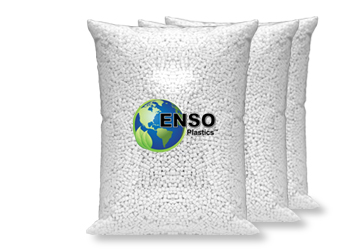ENSO Plastics announces solutions to make plastics more responsible, giving brands more environmental possibilities for plastic packaging.
Mesa, AZ — (SBWIRE) — 05/07/2013 — In the ongoing pursuit to address the growing global plastic pollution issue, environmental plastic solution provider ENSO Plastics announces two new technologies ENSO RENEW™ and ENSO RESTORE™ that have change the way plastics are used around the globe.
ENSO RENEW™ is a unique Renewable Thermo Polymer (RTP) derived from the waste process of agriculture, with a carbon footprint 75% lower than polyethylene. It is a high heat renewable biopolymer that results in home and industrial compostable as well as marine degradable plastics. ENSO RENEW™ is designed to meet the needs of applications looking for renewable solutions to further sustainability goals utilizing fast growing plant based material. Blending ENSO RENEW™ with traditional plastics combines bio-based content with the durability of traditional plastics making them ideal for partially renewable solutions that are durable.
ENSO RESTORE™ is the latest development of biodegradable additives offering superior improvements to biodegradable performance and process-ability/compatibility and eliminating the historical higher scrap rates of competing biodegradable additives, creating a huge environmental and cost advantage. ENSO RESTORE™ is a leading edge technology that accelerates the natural biodegradation without any disruption to disposal method or performance. ENSO RESTORE™ biodegradable additives work with light weighted packaging and thin film applications as well as all major resin types: PE, PP, PET, PS, Rubber, Nitrile, polyurethane and more.
While other companies are simply pursuing the best way to sell first generation products and solutions, ENSO™ is driving innovations by actively creating new solutions for our future generations and effectively dealing with plastic waste.
About ENSO Plastics
ENSO Plastics, LLC is an environmental plastics solutions company with proprietary biodegradable and biobased solutions, bringing to market cost competitive cutting-edge solutions to meet the market demands of sustainability, home or industrial compostability, landfill biodegradability, marine degradability and recyclability.
ENSO Plastics has a mission to solve the global plastics pollution issue by bringing the best technologies to market, finding solutions with the greatest and most productive impact for the plastics industry and providing answers that can be trusted to integrate seamlessly – a platform that companies can stand behind with confidence.
If you are interested in learning more about ENSO Plastics technologies, please visit us at https://ensoplastics.com or call (866) 936-3676 / (602) 639-4228.
Important California Notice
California law prohibits the sale of plastic packaging and plastic products that are labeled with the terms ‘biodegradable,’ ‘degradable,’ or ‘decomposable,’ or any form of those terms, or that imply in any way that the item will break down, biodegrade or decompose in a landfill or other environment. These restrictions apply to all sales in or into the State of California, including such sales over the Internet.





